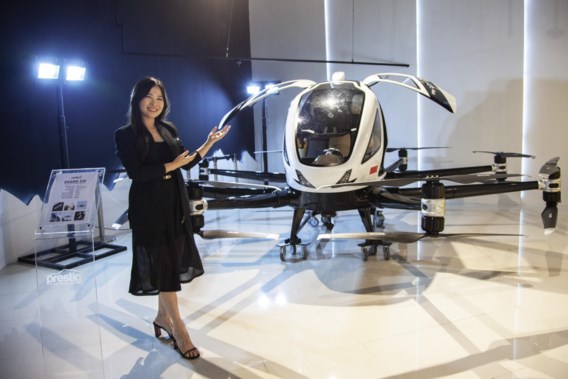Flying taxis, it sounds like science fiction. But what until recently could only be seen in films such as The Fifth Element or the cartoon series The Jetsons, could become reality in China and the Far East in the coming years.
The Chinese company Ehang has entered the final stages of developing a successful ‘eVTOL’, an electric vehicle that takes off and lands vertically. After more than 2,000 test flights with passengers and a series of successful commercial flights in its home base of Guangzhou and Hefei, Ehang received the official green light from Beijing this week to produce and sell its unmanned flying taxi (the EH216-S) on a large scale.
Up to 130 kilometers per hour
The EH216-S is therefore well on schedule to become the first commercially deployed air taxi in the world. According to Ehang’s website, the certified air taxi is a two-seat electric aircraft for short-distance travel, equipped with 16 propellers powered by multiple electric batteries.
The flying taxi reaches a top speed of 130 kilometers per hour, has a maximum range of 35 km and can stay in the air for a maximum of 21 minutes. The futuristic-looking vehicle has room for two passengers. It takes two hours to recharge the electric batteries. And according to Reuters, the unmanned air taxi was provisionally priced at 2.39 million yuan (more than 306,000 euros).
Strategic growth sector
The gamble Ehang is taking with this new showpiece may be smaller than you think. While Elon Musk is fully committed to self-driving robotaxis on the ground, drone manufacturer Ehang is consciously aiming to expand another promising market: that of the flying robotaxis. China wants to turn the so-called ‘low-fly economy’ – a neologism for commercial aviation activities up to 1,000 meters altitude – into a strategic growth sector that should eventually generate tens of billions in new revenues.
Across the country, Chinese companies investing in the low-flying economy receive generous subsidies from Beijing. Not only for the production of new air taxis, but also for the construction of supporting infrastructure, such as fixed landing sites and flight verification by control towers. In metro cities such as Shenzhen, there is already targeted government support for supporting companies that set up low-altitude flight routes for the new means of transport.
In the West people look on with envy. While rival companies such as Airbus, Volocopter, Lilium and Joby are also eager to fulfill the flying taxi dream – unmanned or otherwise – none of these companies have yet obtained the necessary certification from the European aviation watchdog EASA. As a result, Western producers are in danger of being beaten in speed by the Chinese Ehang.
Worldwide first
The approval for commercial production for Ehang is a world first in the sector. According to Chinese media, it also opens the gate to new licenses elsewhere in the world. For example, in 2022, Ehang’s unmanned flying taxi already completed a demo flight tour of four cities in Japan. It is therefore not surprising that there are plans to use the EH216-S at the Osaka World Exhibition next year.
That is not a coincidence. In China itself, the flying robotaxi will probably be used mainly for tourism. Xiyu Tourism is gearing up to launch low-altitude tourism activities all over China with more than 100 Ehang air taxis in the next five years. But Japan AirX, Aerotree in Malaysia and Prestige in Indonesia have also jointly ordered more than 1,000 air taxis through so-called preorders.
Important barriers
However, caution is advised. Before you can take a flight with the EH216-S, the industry still has many hurdles to overcome. For example, so-called vertiports must first be installed everywhere, permanent take-off and landing sites for flying taxis. And this is best done at strategic locations, linked to other forms of transport and equipped with loading options.
People are already working hard on this in China. But in Europe, only two locations have been officially approved, without any decisions having been made about additional security such as control towers, baggage checks or passport checks.
Strict safety standards
The most important barrier is perhaps public acceptance. Will we simply accept that the flying taxis will soon buzz loudly around our ears? Still other questions await answers. Such as: do large cities have the space for these types of flying taxis? And will such an air ride be reserved for the happy few?
And above all, how do you prevent aircraft from crashing and causing additional victims on the ground? In Europe, aircraft may have to prove that they are so safe that a maximum of one catastrophic problem may occur per billion flight hours. That is a lot stricter than for many helicopters. The future will show whether the Chinese EH216-S will be able to meet this requirement.


